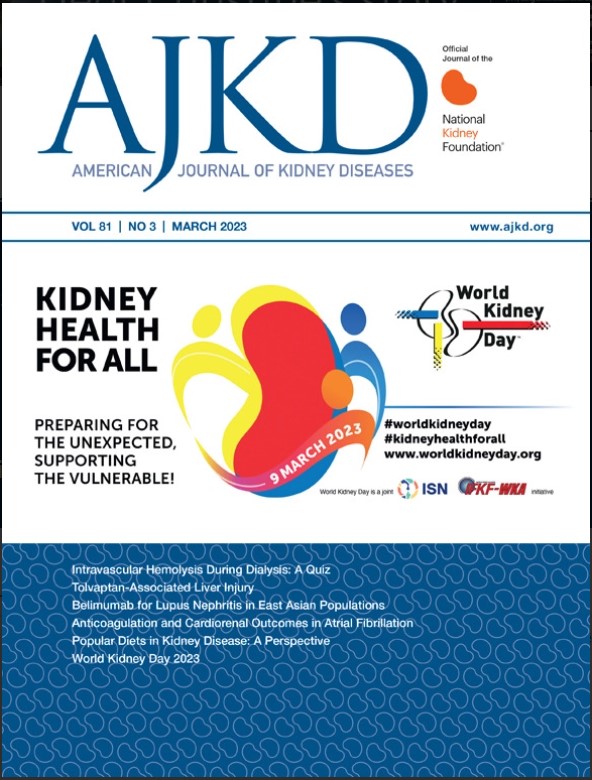Complex Etiologies of the Discordance Between Cystatin C– and Creatinine-Based Estimated GFR and Its Adverse Associations: Findings From the CRIC Study
IF 8.2
1区 医学
Q1 UROLOGY & NEPHROLOGY
引用次数: 0
Abstract
Rationale & Objective
The difference between glomerular filtration rate (GFR) estimated by cystatin C and creatinine (eGFRdiff, defined as eGFRcys − eGFRcr) has been repeatedly associated with adverse outcomes, often ascribed to low muscle mass. However, it is unclear to what extent putative determinants of eGFRdiff, such as low muscle mass, explain associations between eGFRdiff and the outcomes of death and heart failure. Determinants of eGFRdiff have not been investigated to assess their impacts on eGFRcys, eGFRcr, and ultimately eGFRdiff in a dataset with measured GFR.
Study Design
Prospective cohort study for outcomes of eGFRdiff and cross-sectional study for determinants of eGFRdiff.
Setting & Participants
1,290 adult participants in the Chronic Renal Insufficiency Cohort (CRIC) Study with directly measured iothalamate GFR, 24-hour urine creatinine collections, and plasma measurements of larger molecules such as β2-microglobulin.
Exposure
Baseline eGFRdiff (eGFRcys − eGFRcr) for prospective analysis; putative eGFRdiff determinants for cross-sectional analyses.
Outcome
Time to all-cause death, heart failure hospitalization for prospective analyses, and eGFR for cross-sectional analyses.
Analytical Approach
Cox proportional hazards regression for prospective analysis and linear regression for cross-sectional analyses.
Results
Among adults with CKD, a more positive eGFRdiff was associated with decreased risk of death (adjusted HR, 0.80 [95% CI, 0.74-0.88]) and heart failure hospitalization (adjusted HR 0.83 [95% CI, 0.73-94]). Neither association was substantially changed by adjustment for putative determinants of eGFRdiff. Estimated GFRdiff was weakly correlated with markers of muscle mass, middle molecule clearance, and other putative determinants of eGFRdiff (eg, obesity, inflammation). Only 36% of the variance in eGFRdiff was explained by these factors.
Limitations
Imprecision in measurements such as 24-hour urine collections.
Conclusions
The associations of eGFRdiff with adverse outcomes were unchanged by adjustment for markers of putative determinants such as muscle mass. Examined putative determinants of eGFRdiff accounted for a minority of the variance in eGFRdiff.
Plain-Language Summary
The difference between estimated glomerular filtration rates (eGFRdiff) using serum creatinine and cystatin C (eGFRcys − eGFRcr) has been repeatedly associated with adverse outcomes, including death and heart failure. The biological mechanisms underlying eGFRdiff are unclear. In this study of adult patients with CKD, we found that adjustment for these proposed causes of eGFRdiff, including measures of muscle mass and protein intake (daily urine creatinine excretion) and kidney clearance of larger molecules (β2-microglobulin and β-trace protein levels relative to measured GFR), did not change the associations between eGFRdiff and subsequent adverse outcomes. Only 36% of the variance in eGFRdiff was accounted for by the proposed causes. Further research is needed to uncover the pathophysiology behind these associations.
基于胱抑素C和肌酐的估计GFR不一致及其不良关联的复杂病因:来自CRIC研究的发现。
理由与目的:胱抑素C和肌酐(eGFRdiff,定义为eGFRCys - eGFRCr)估算的GFR之间的差异一再与不良结局相关,通常归因于低肌肉质量。然而,目前尚不清楚eGFRdiff的推定决定因素,如低肌肉质量,在多大程度上解释了eGFRdiff与死亡和心力衰竭结果之间的关联。尚未研究eGFRdiff的决定因素,以评估在测量GFR的数据集中对eGFRCys、eGFRCr和最终eGFRdiff的影响。研究设计:eGFRdiff结果的前瞻性队列研究和eGFRdiff决定因素的横断面研究。背景和参与者:1290名慢性肾功能不全队列(CRIC)研究的成年参与者,直接测量碘酸盐GFR、24小时尿肌酐收集和血浆中大分子(如β -2微球蛋白)的测量。横断面分析的推定eGFRdiff决定因素。结局:前瞻性分析的全因死亡时间,心力衰竭住院;eGFR用于横断面分析。分析方法:Cox比例风险回归用于前瞻性分析,线性回归用于横断面分析。结果:在成人CKD患者中,eGFRdiff阳性与死亡风险降低(aHR 0.80, 95% CI 0.74-0.88)和心力衰竭住院(aHR 0.83, 95% CI 0.73-94)相关。调整eGFRdiff的推定决定因素后,这两种关联都没有实质性改变。eGFRdiff与肌肉质量、中间分子清除率和其他可能的eGFRdiff决定因素(如肥胖、炎症)的标志物呈弱相关。只有36%的eGFRdiff变异可以用这些因素来解释。局限性:测量不精确,如24小时尿液收集。结论:eGFRdiff与不良结局的关联通过调整假定决定因素的标记(如肌肉质量)没有改变。经检验的eGFRdiff的推定决定因素只占eGFRdiff变异的一小部分。
本文章由计算机程序翻译,如有差异,请以英文原文为准。
求助全文
约1分钟内获得全文
求助全文
来源期刊

American Journal of Kidney Diseases
医学-泌尿学与肾脏学
CiteScore
20.40
自引率
2.30%
发文量
732
审稿时长
3-8 weeks
期刊介绍:
The American Journal of Kidney Diseases (AJKD), the National Kidney Foundation's official journal, is globally recognized for its leadership in clinical nephrology content. Monthly, AJKD publishes original investigations on kidney diseases, hypertension, dialysis therapies, and kidney transplantation. Rigorous peer-review, statistical scrutiny, and a structured format characterize the publication process. Each issue includes case reports unveiling new diseases and potential therapeutic strategies.
 求助内容:
求助内容: 应助结果提醒方式:
应助结果提醒方式:


